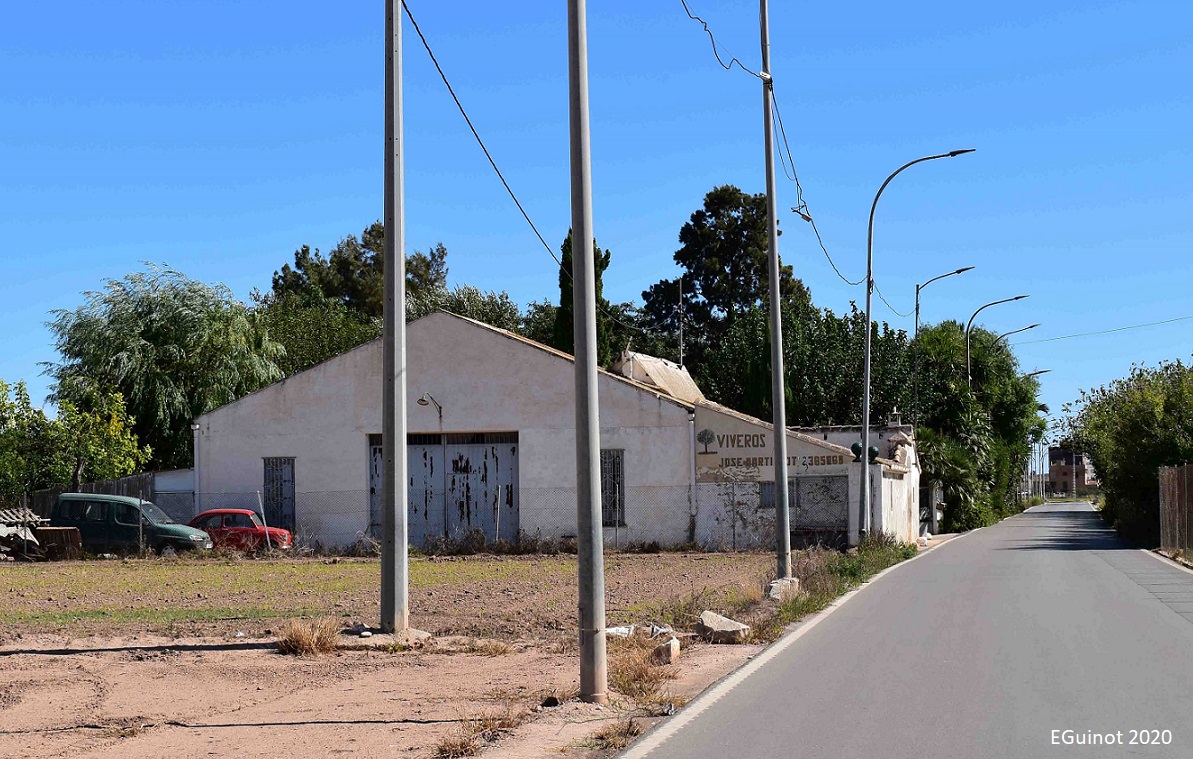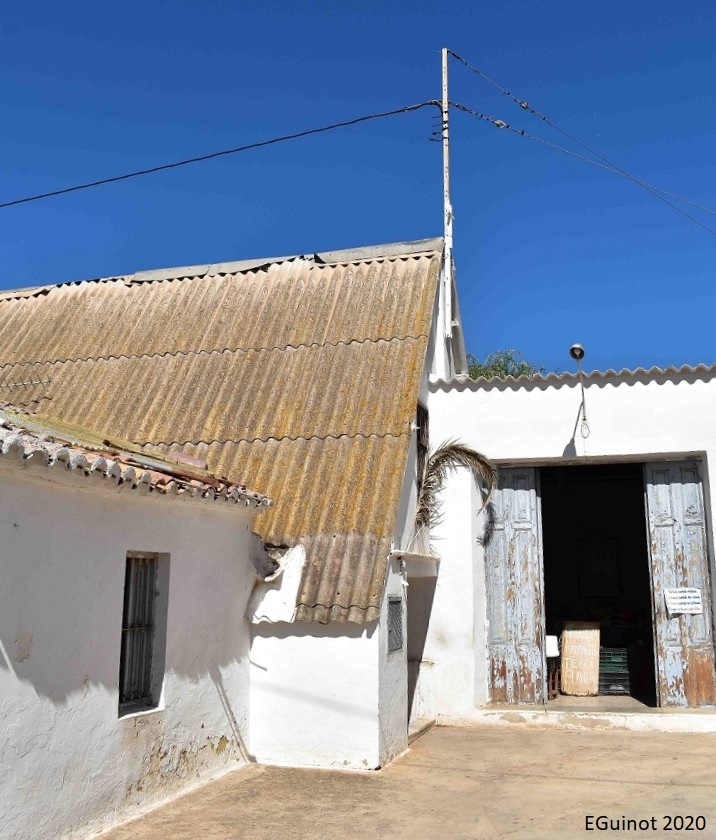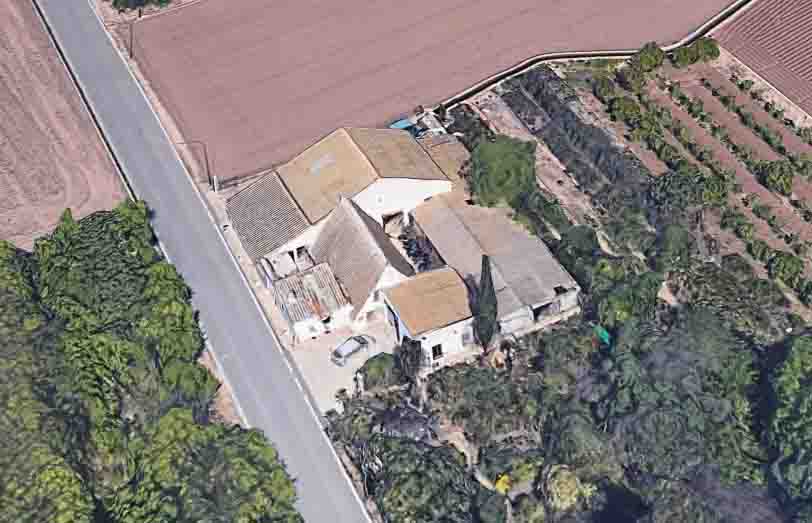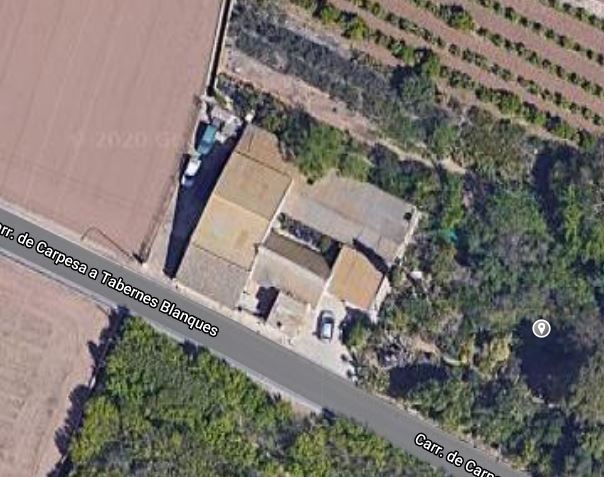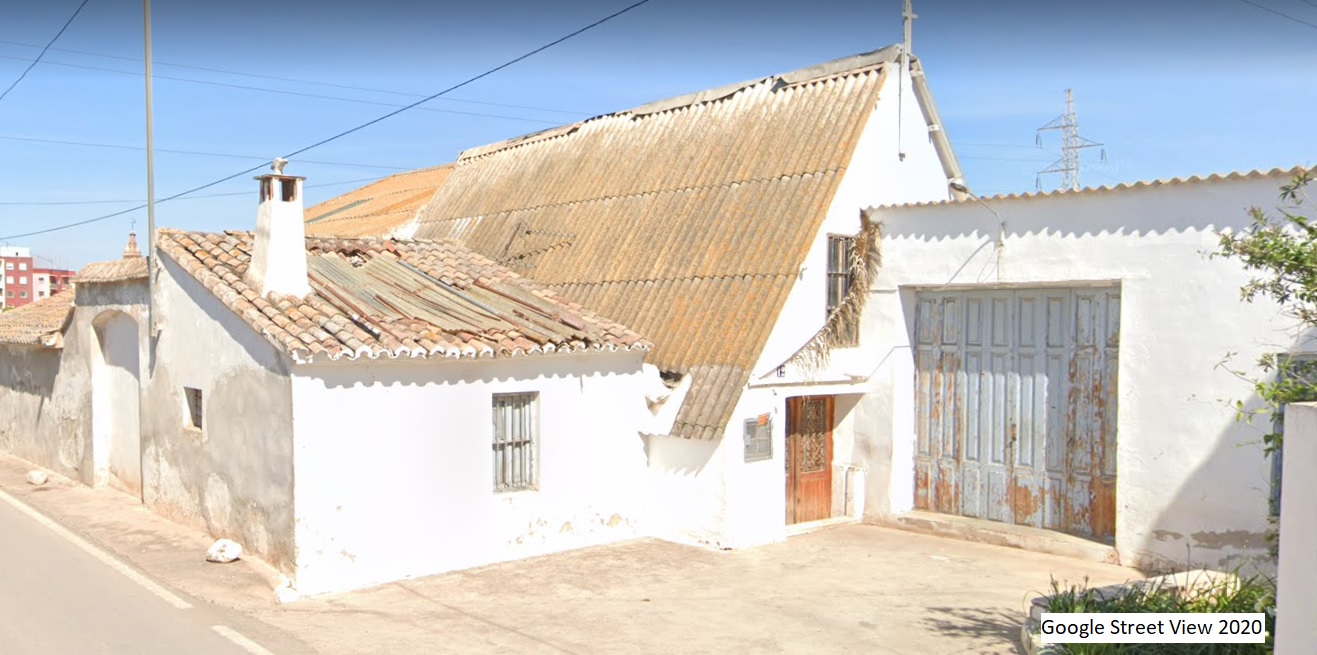
It is located in the middle of the irrigated land, between Carpesa and Tavernes Blanques. The address is: Partida del Molí dels canyars n. 12. The way to get there is through one of these two towns and take the road that goes to the other. The barraca (hut), which is embedded in a house or alqueria (farmhouse), is right next to the road and the garden centre that belong to it.
The barraca (hut) retains its traditional structure, with the usual replacement of the roof with fibre-concrete slabs and is half-timbered and hidden in the house of the alqueria (farmhouse) of which it forms part.
XIX-XX centuries.
According to J. A. García Esparza (2012) this barraca (hut) would be about 200 years old but, as in the case of many of these popular buildings in l’Horta (the irrigated land of València), it is not easy to give a more specific chronology. As in the whole of the periphery of the city of València, many of these barraques (huts) were built during the 19th or early 20th century, even with possible important modifications on the same plot. These barraques do not usually appear in the documents of past centuries in an identifiable form by names or place names, while at an oral level they were usually known in their surroundings by the name or nickname of the people who owned or lived there. For this reason, the name of the barraca was frequently modified due to the change of residence of these people, and it is difficult to determine the specific history of the owners, works, etc., without family witnesses. This would be the case, for example, with regard to the current name: alquería (farmhouse) of Nàsio (Ignaci) or Martí Biot, which is also a commercial name for agricultural products. For years it has been a commercial garden centre for plants and trees, as well as a house and an agricultural warehouse.
According to M. Del Rey and A. Gallud (PGOU of València, 2013, and PAT of l’Horta 2018), this barraca (hut) is still located in an irrigated landscape in perfect condition between Carpesa and Tavernes Blanques, and forms part of anensemble with three annexes also on the ground floor and of different periods, construction types and uses, which enclose part of the barraca itself and only leave half of the façade and its floor visible. The barraca is of the hallway type and the walls, beams and door and window openings appear to be in good condition. The most significant change is the roof, which is now made of corrugated fibre concrete sheets. According to J. A. García Esparza (2012), the barraca is built of adobe, masonry and brick, whitewashed on the outside. It has a rectangular floor plan with a surface area of 62.68 m2 (674.6ft2), a façade width of 6.30 m (20ft 8in) and a length of 9.05 m (29ft 8.2in). The height is 6.35 m (20ft 10in). It has a height of 6.35 m. The height is 6.35m (20ft 10in). It currently has electricity and well water.
BRL-BRR-PAT HORTA
- Revisió simplificada del Pla General de Valencia (2013): Catàleg de Bens i Espais Protegits de natura rural. (EPA-SNU_17.07), pp. 175-178.
- Pla d’Acció Territorial d’Ordenació i Dinamització de l’Horta de València (PAT de l’Horta). Generalitat Valenciana, 2018. Catàleg annex. Element Patrimonial EPA_09.04, pp. 393-395.
- Inventari General del Patrimoni Cultural Valencià, Conselleria de Cultura, Generalitat Valenciana, Béns del Catàleg d’Etnologia, fitxa: “Barraca i casa de Martí Biot (Carpesa)”.
- Infoagro
GARCÍA ESPARZA, J. A.(2012): Barracas del litoral mediterráneo. Catálogo de Valencia y su entorno, Castelló, Publicacions de la Universitat Jaume I, pp. 144-145 .
DEL REY, M. (2010): Arquitectura Rural Valenciana, Barcelona: Galerada (1ª edició: València: Direcció General de Patrimoni Artístic, 1996).
GARCÍA ESPARZA, J. A. (2008): “La barraca valenciana, procesos de transformación”, Revista valenciana d'etnologia, n. 3, pp. 145-159.
CRUZ OROZCO, J. (2003): “Las viviendas de cubierta vegetal en el territorio valenciano: el caso de la barraca”, Revista El Pajar: Cuaderno de Etnografía Canaria, n. 14, pp. 111-116.
SANCHIS GUARNER, M. (1957): Les barraques valencianes, Barcelona, Ed. Barcino (reedició: València, Institució Alfons el Magnànim, 1999).
ALMELA VIVES, F. (1960): La vivienda rural valenciana, Valencia, La Semana Gráfica.
CASAS TORRES, J. M. (1944): La vivienda y los núcleos rurales de la huerta de Valencia, València, Diputació Provincial de València.
RUIZ RUBIO, J. V. (1999): Construint una barraca valenciana, València, Ajuntament d’Alboraia-Col·legi d’Aparelladors i Arquitectes Tècnics de València-Col·legi d’Arquitectes de la Comunitat Valenciana.
GOSÁLVEZ, V.(1915): Estudio constructivo de la Barraca de la Vega Valenciana, Tema de investigación presentado al tribunal de oposiciones. Manuscrito. Biblioteca del COAV. València (Facsimil de: “La Barraca Valenciana”, COACV-Colegio Oficial de Arquitectos de la Comunidad Valenciana, 1998).
Photos: E. Guinot, Google Earth



